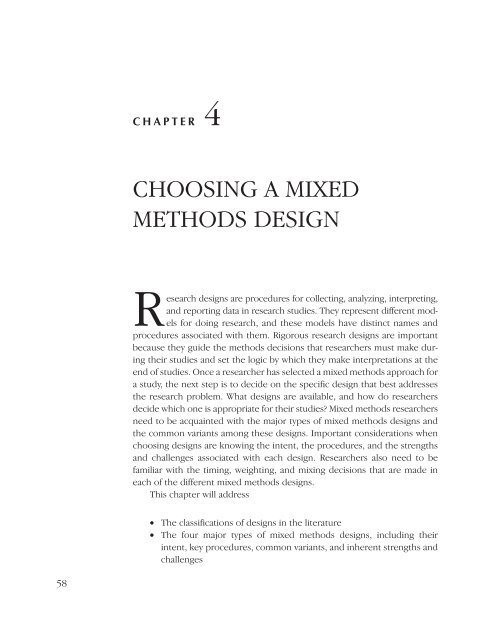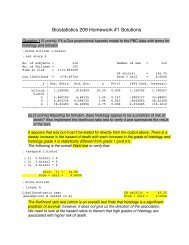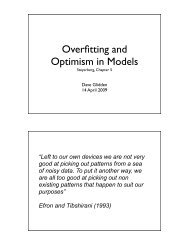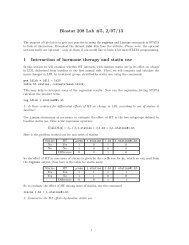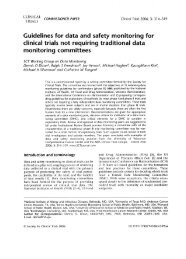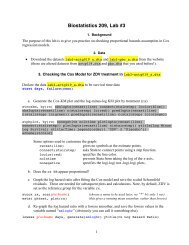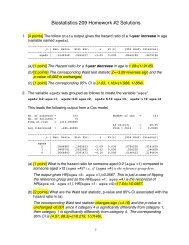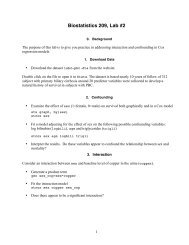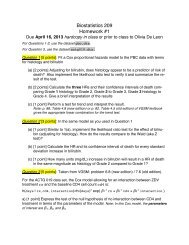choosing a mixed methods design - SF Coordinating Center Study ...
choosing a mixed methods design - SF Coordinating Center Study ...
choosing a mixed methods design - SF Coordinating Center Study ...
Create successful ePaper yourself
Turn your PDF publications into a flip-book with our unique Google optimized e-Paper software.
04-Creswell (Designing)-45025.qxd 5/16/2006 8:35 PM Page 58CHAPTER 4CHOOSING A MIXEDMETHODS DESIGNResearch <strong>design</strong>s are procedures for collecting, analyzing, interpreting,and reporting data in research studies. They represent different modelsfor doing research, and these models have distinct names andprocedures associated with them. Rigorous research <strong>design</strong>s are importantbecause they guide the <strong>methods</strong> decisions that researchers must make duringtheir studies and set the logic by which they make interpretations at theend of studies. Once a researcher has selected a <strong>mixed</strong> <strong>methods</strong> approach fora study, the next step is to decide on the specific <strong>design</strong> that best addressesthe research problem. What <strong>design</strong>s are available, and how do researchersdecide which one is appropriate for their studies? Mixed <strong>methods</strong> researchersneed to be acquainted with the major types of <strong>mixed</strong> <strong>methods</strong> <strong>design</strong>s andthe common variants among these <strong>design</strong>s. Important considerations when<strong>choosing</strong> <strong>design</strong>s are knowing the intent, the procedures, and the strengthsand challenges associated with each <strong>design</strong>. Researchers also need to befamiliar with the timing, weighting, and mixing decisions that are made ineach of the different <strong>mixed</strong> <strong>methods</strong> <strong>design</strong>s.This chapter will address• The classifications of <strong>design</strong>s in the literature• The four major types of <strong>mixed</strong> <strong>methods</strong> <strong>design</strong>s, including theirintent, key procedures, common variants, and inherent strengths andchallenges58
SHTM 2024 (Pt 1): LiftsContents1. Scope page 31.1 General1.2 User considerations2. Management responsibilities page 42.2 Statutory requirements2.3 Functional guidance2.5 Safety applications3. Functional overview page 63.1 Types of lift3.8 Categories of lift4. Testing and inspection criteria page 85. Management summary page 96. Designated staff functions page 107. Definitions page 12References page 14ARCHIVEVersion 2.0: June 2001 Page 2 of 19© Borders General Hospital NHS Trust on behalf ofNHSScotland Property and Environment Forum
04-Creswell (Designing)-45025.qxd 5/16/2006 8:35 PM Page 6060–●–DESIGNING AND CONDUCTING MIXED METHODS RESEARCHTable 4.1AuthorMixed Method Design ClassificationsMixed Method DesignsDisciplineGreene, Caracelli,and Graham(1989)Patton (1990)Morse (1991)Steckler, McLeroy,Goodman, Bird,and McCormick(1992)Greene andCaracelli (1997)InitiationExpansionDevelopmentComplementaryTriangulationExperimental <strong>design</strong>, qualitative data, andcontent analysisExperimental <strong>design</strong>, qualitative data, andstatistical analysisNaturalistic inquiry, qualitative data, andstatistical analysisNaturalistic inquiry, quantitative data, andstatistical analysisSimultaneous triangulationQUAL + quanQUAN + qualSequential triangulationQUAL → quanQUAN → qualModel 1: Qualitative <strong>methods</strong> to developquantitative measuresModel 2: Qualitative <strong>methods</strong> to explainquantitative findingsModel 3: Quantitative <strong>methods</strong> to embellishqualitative findingsModel 4: Qualitative and quantitative<strong>methods</strong> used equally and parallelComponent <strong>design</strong>sTriangulationComplementaryExpansionIntegrated <strong>design</strong>sIterativeEmbedded or nestedHolisticTransformativeEvaluationEvaluationNursingPublic health educationEvaluation
SHTM 2024 (Pt 1): Lifts2. Management responsibilities2.1 It is incumbent on management to ensure that their lift installations complywith all the statutory regulations applicable to lifts on their premises. Otherfunctional guidance in terms of standards and codes of practice should alsobe noted.Statutory requirements2.2 Safety regulations are as laid down in the:a. Offices, Shops and Railway Premises (Hoists and Lifts) Regulations1968;b. Health and Safety at Work etc Act 1974;c. Electricity at Work Regulations 1989;d. Fire Precautions Act 1971, (as amended by the Fire Safety and Safetyof Places of Sport Act 1987),e. Factories Act 1961 (as amended);f. The Building Standard (Scotland) Regulations 1990 (as amended);g. Lifting Operations and Lifting Equipment Regulations 1998;h. Management of Health and Safety at Work Regulations 1999;i. Workplace (Health, Safety and Welfare) Regulations 1992;j. Construction (Design and Management) Regulations 1994;k. Reporting of Injuries, Diseases and Dangerous OccurrencesRegulations 1995 (RIDDOR);l. Electromagnetic Compatibility Regulations 1992, (as amended);m. Supply of Machinery (Safety) Regulations 1992.Functional guidance2.3 Guidance is as laid down in:ARCHIVEa. British Standards and Codes of Practice;b. Health and Safety Executive Guidance;c. NHS Model Engineering Specifications;d. Health Building Notes;e. Scottish Hospital Technical Notes;f. Scottish Health Technical Memoranda and NHS in Scotland Firecode;Version 2.0: June 2001 Page 4 of 19© Borders General Hospital NHS Trust on behalf ofNHSScotland Property and Environment Forum
04-Creswell (Designing)-45025.qxd 5/16/2006 8:35 PM Page 6262–●–DESIGNING AND CONDUCTING MIXED METHODS RESEARCHTable 4.1 (Continued)AuthorCreswell, Fetters,and Ivankova(2004)Tashakkori andTeddlie (2003b)Mixed Method DesignsInstrument <strong>design</strong> modelTriangulation <strong>design</strong> modelData transformation <strong>design</strong> modelMultistrand <strong>design</strong>sConcurrent <strong>mixed</strong> <strong>design</strong>sConcurrent <strong>mixed</strong> method <strong>design</strong>Concurrent <strong>mixed</strong> model <strong>design</strong>Sequential <strong>mixed</strong> <strong>design</strong>sSequential <strong>mixed</strong> method <strong>design</strong>Sequential <strong>mixed</strong> model <strong>design</strong>Multistrand conversion <strong>mixed</strong> <strong>design</strong>sMultistrand conversion <strong>mixed</strong> method <strong>design</strong>Multistrand conversion <strong>mixed</strong> model <strong>design</strong>Fully integrated <strong>mixed</strong> model <strong>design</strong>DisciplinePrimary medical careSocial and behavioralresearchSOURCE: Adapted from Creswell, Plano Clark, et al. (2003, pp. 216-217, Table 8.1).The Triangulation DesignThe most common and well-known approach to mixing <strong>methods</strong> is theTriangulation Design (Figure 4.1a) (Creswell, Plano Clark, et al., 2003). The purposeof this <strong>design</strong> is “to obtain different but complementary data on the sametopic” (Morse, 1991, p. 122) to best understand the research problem. The intentin using this <strong>design</strong> is to bring together the differing strengths and nonoverlappingweaknesses of quantitative <strong>methods</strong> (large sample size, trends, generalization)with those of qualitative <strong>methods</strong> (small N, details, in depth) (Patton, 1990).This <strong>design</strong> and its underlying purpose of converging different <strong>methods</strong> hasbeen discussed extensively in the literature (e.g., Jick, 1979; Brewer & Hunter,1989; Greene et al., 1989; Morse, 1991). This <strong>design</strong> is used when a researcherwants to directly compare and contrast quantitative statistical results with qualitativefindings or to validate or expand quantitative results with qualitative data.Triangulation Design Procedures. The Triangulation Design is a one-phase<strong>design</strong> in which researchers implement the quantitative and qualitative
04-Creswell (Designing)-45025.qxd 5/16/2006 8:35 PM Page 63Choosing a Mixed Methods Design–●–63(a) Triangulation DesignQUANQUALInterpretation based onQUAN + QUAL results(b) Triangulation Design: Convergence ModelQUANdatacollectionQUANdataanalysisQUANresultsCompareandcontrastInterpretationQUAN + QUALQUALdatacollectionQUALdataanalysisQUALresults(c) Triangulation Design: Data Transformation Model (Transforming QUAL data into QUAN)QUANdatacollectionQUAN data analysisCompare andinterrelate twoQUAN data setsInterpretationQUAN + QUALQUALdatacollectionQUALdataanalysisTransformQUAL intoquan data(d) Triangulation Design: Validating Quantitative Data ModelQUAN datacollection:Surveyqualdata collection:Open-endedsurvey itemsQUANdataanalysisqualdataanalysisQUANresultsqualresultsValidate QUANresults withqual resultsInterpretationQUAN + qualFigure 4.1(Continued)
04-Creswell (Designing)-45025.qxd 5/16/2006 8:35 PM Page 6464–●–DESIGNING AND CONDUCTING MIXED METHODS RESEARCH(e) Triangulation Design: Multilevel ModelLevel 1:QUANdata collection, analysis, resultsLevel 2:QUALdata collection, analysis, resultsOverallinterpretationLevel 3:QUANdata collection, analysis, resultsFigure 4.1The Triangulation Design<strong>methods</strong> during the same timeframe and with equal weight (see Figure 4.1a).The single-phase timing of this <strong>design</strong> is the reason it has also been referredto as the “concurrent triangulation <strong>design</strong>” (Creswell, Plano Clark, et al.,2003). It generally involves the concurrent, but separate, collection andanalysis of quantitative and qualitative data so that the researcher may bestunderstand the research problem. The researcher attempts to merge the twodata sets, typically by bringing the separate results together in the interpretationor by transforming data to facilitate integrating the two data types duringthe analysis. Jenkins’ (2001) single-phase study (appendix A) of ruraladolescent perceptions of alcohol and other drug resistance is an example ofa Triangulation Design. She collected and analyzed quantitative and qualitativedata and merged the two data sets into one overall interpretation, inwhich she related the quantitative results to the qualitative findings.Variants of the Triangulation Design. The four variants are the convergencemodel, the data transformation model, the validating quantitative datamodel, and the multilevel model. The first two models differ in terms of howthe researcher attempts to merge the two data types (either during interpretationor during analysis), the third model is used to enhance findings froma survey, and the fourth is used to investigate different levels of analysis.The convergence model (Figure 4.1b) represents the traditional modelof a <strong>mixed</strong> <strong>methods</strong> triangulation <strong>design</strong> (Creswell, 1999). In this model, theresearcher collects and analyzes quantitative and qualitative data separatelyon the same phenomenon and then the different results are converged (bycomparing and contrasting the different results) during the interpretation.Researchers use this model when they want to compare results or to validate,
04-Creswell (Designing)-45025.qxd 5/16/2006 8:35 PM Page 65Choosing a Mixed Methods Design–●–65confirm, or corroborate quantitative results with qualitative findings. Thepurpose of this model is to end up with valid and well-substantiated conclusionsabout a single phenomenon. For example, Anderson, Newell, andKilcoyne (1999) converged their quantitative survey results with their qualitativefocus group findings to better understand the motivations of collegestudent plasma donors.Researchers may choose to use the data transformation model (Figure4.1c) (Creswell et al., 2004). This model also involves the separate collectionand analysis of quantitative and qualitative data sets. However, after the initialanalysis, the researcher uses procedures to transform one data type intothe other data type. This is accomplished by either quantifying qualitativefindings or qualifying quantitative results (Tashakkori & Teddlie, 1998). Thistransformation allows the data to be <strong>mixed</strong> during the analysis stage and facilitatesthe comparison, interrelation, and further analysis of the two data sets.The study of parental values by Pagano, Hirsch, Deutsch, and McAdams(2002) is an example of this model. In their study, they derived qualitativethemes from the qualitative data and then scored those themes dichotomouslyas present or not present for each participant. These quantifiedscores were then analyzed with the quantitative data, using correlations andlogistical regression to identify relationships between categories, as well asgender and racial differences.Researchers use the validating quantitative data model (Figure 4.1d)when they want to validate and expand on the quantitative findings from asurvey by including a few open-ended qualitative questions. In this model,the researcher collects both types of data within one survey instrument.Because the qualitative items are an add-on to a quantitative survey, the itemsgenerally do not result in a rigorous qualitative data set. However, they providethe researcher with interesting quotes that can be used to validate andembellish the quantitative survey findings. For example, Webb, Sweet, andPretty (2002) included qualitative questions in addition to their quantitativesurvey measures in their study of the emotional and psychological impact ofmass casualty incidents on forensic odontologists. Webb et al. used the qualitativedata to validate the quantitative results from the survey items.The fourth variant of the Triangulation Design is what Tashakkori andTeddlie (1998) referred to as “multilevel research” (p. 48). In a multilevelmodel (Figure 4.1e), different <strong>methods</strong> (quantitative and qualitative) areused to address different levels within a system. The findings from each levelare merged together into one overall interpretation. For example, Elliott andWilliams (2002) studied an employee counseling service using qualitativedata at the client level, qualitative data at the counselor level, qualitative datawith the directors, and quantitative data for the organizational level.
04-Creswell (Designing)-45025.qxd 5/16/2006 8:35 PM Page 6666–●–DESIGNING AND CONDUCTING MIXED METHODS RESEARCHStrengths of the Triangulation Design. This <strong>design</strong> has a number of strengthsand advantages, including the following:• The <strong>design</strong> makes intuitive sense. Researchers new to <strong>mixed</strong> <strong>methods</strong>often choose this <strong>design</strong>. It was the <strong>design</strong> first discussed in the literature(Jick, 1979), and it has become a framework for thinking about<strong>mixed</strong> <strong>methods</strong> research.• It is an efficient <strong>design</strong>, in which both types of data are collectedduring one phase of the research at roughly the same time.• Each type of data can be collected and analyzed separately and independently,using the techniques traditionally associated with eachdata type. This lends itself to team research, in which the team caninclude individuals with both quantitative and qualitative expertise.Challenges in Using the Triangulation Design. Although this <strong>design</strong> is themost popular <strong>mixed</strong> <strong>methods</strong> <strong>design</strong>, it is also probably the most challengingof the four major types of <strong>design</strong>s. Here are some of the challenges facingresearchers using a variant of the Triangulation Design as well as options foraddressing them.For all variants:• Much effort and expertise is required, particularly because of the concurrentdata collection and the fact that equal weight is usually givento each data type. This can be addressed by forming a research teamthat includes members who have quantitative and qualitative expertise,by including researchers who have quantitative and qualitativeexpertise on graduate committees, or by training single researchers inboth quantitative and qualitative research.• Researchers may face the question of what to do if the quantitativeand qualitative results do not agree. These differences can be difficultto resolve and may require the collection of additional data. The questionthen develops as to what type of additional data to collect, quantitativedata, qualitative data, or both? Chapter 6 discusses thecollection of additional data or the reexamination of existing data toaddress this challenge.For the convergence model:• Researchers need to consider the consequences of having differentsamples and different sample sizes when converging the two data sets.Different sample sizes are inherent in the <strong>design</strong> because quantitative
04-Creswell (Designing)-45025.qxd 5/16/2006 8:35 PM Page 67and qualitative data are usually collected for different purposes(generalization vs. in-depth description, respectively). Researcherscan consider collecting large qualitative samples or weighting thecases (see Chapter 6).• It can be very challenging to converge (integrate) two sets of very differentdata and their results in a meaningful way. Chapter 7 providestechniques for building comparison matrices. In addition, researchersneed to <strong>design</strong> their studies so that the quantitative and qualitative dataaddress the same concepts. This strategy facilitates merging the data.For the data transformation model:Choosing a Mixed Methods Design–●–67• Researchers need to develop procedures for transforming data andmake decisions about how the data will be transformed. In general, itis easier for researchers to quantify their qualitative data by transformingqualitative codes or themes into counts or ratings (see Chapter 7).The Embedded DesignThe Embedded Design is a <strong>mixed</strong> <strong>methods</strong> <strong>design</strong> in which one data setprovides a supportive, secondary role in a study based primarily on the otherdata type (see Figure 4.2a) (Creswell, Plano Clark, et al., 2003). The premisesof this <strong>design</strong> are that a single data set is not sufficient, that different questionsneed to be answered, and that each type of question requires differenttypes of data. Researchers use this <strong>design</strong> when they need to include qualitativeor quantitative data to answer a research question within a largelyquantitative or qualitative study. This <strong>design</strong> is particularly useful when aresearcher needs to embed a qualitative component within a quantitative<strong>design</strong>, as in the case of an experimental or correlational <strong>design</strong>. In the experimentalexample, the investigator includes qualitative data for several reasons,such as to develop a treatment, to examine the process of an interventionor the mechanisms that relate variables, or to follow up on the results of anexperiment.Embedded Design Procedures. The Embedded Design mixes the differentdata sets at the <strong>design</strong> level, with one type of data being embedded within amethodology framed by the other data type (Caracelli & Greene, 1997). Forexample, a researcher could embed qualitative data within a quantitativemethodology, as might be done in an experimental <strong>design</strong>, or quantitativedata could be embedded within a qualitative methodology, as could be done
04-Creswell (Designing)-45025.qxd 5/16/2006 8:35 PM Page 6868–●–DESIGNING AND CONDUCTING MIXED METHODS RESEARCH(a) Embedded DesignQUANqualInterpretationbased onQUAN(qual)resultsorQUALquanInterpretationbased onQUAL(quan)results(b) Embedded Design: Embedded Experimental ModelqualbeforeinterventionQUANpremeasureInterventionQUANpostmeasurequalafterinterventionInterpretationbased onQUAN(qual)resultsqualduringintervention(c) Embedded Design: Embedded Correlational ModelQUANPredictorsQUANPredictorsQUANPredictorsQUANOutcomeInterpretationbased onQUAN(qual)resultsqualprocessFigure 4.2The Embedded Designin a phenomenology <strong>design</strong> (see Figure 4.2a). The Embedded Designincludes the collection of both quantitative and qualitative data, but one ofthe data types plays a supplemental role within the overall <strong>design</strong>. AnEmbedded Design can use either a one-phase or a two-phase approach forthe embedded data (see Figure 4.2b), and the quantitative and qualitative
04-Creswell (Designing)-45025.qxd 5/16/2006 8:35 PM Page 69Choosing a Mixed Methods Design–●–69data are used to answer different research questions within the study(Hanson et al., 2005). For example, Rogers et al. (2003) (appendix B) embeddedqualitative data within their experimental <strong>design</strong> in two different ways:before the intervention, to inform the development of the treatment, andafter the intervention, to explain the treatment results.It can be a challenge to differentiate between a study using an EmbeddedDesign and a study using one of the other <strong>mixed</strong> <strong>methods</strong> <strong>design</strong>s. The keyquestion is whether the secondary data type is playing a supplemental rolewithin a <strong>design</strong> based on the other data type. Consider the question: Wouldthe results of the secondary data type be useful or meaningful if they werenot embedded within the other data set? For example, Rogers et al.’s (2003)qualitative explanation of the treatment results would not make much senseor have value if there had not been outcomes measured from an experimentalstudy using those treatments.Variants of the Embedded Design. Although many variants of the EmbeddedDesign are possible, there are two variants that we will discuss. These are theexperimental model and the correlational model.The embedded experimental model (Figure 4.2b) may be the most commonlyused variant of the Embedded Design (Creswell, Fetters, & PlanoClark, 2005). This model is defined by having qualitative data embeddedwithin an experimental <strong>design</strong> (such as a true experiment or a quasiexperiment).The priority of this model is established by the quantitative, experimentalmethodology, and the qualitative dataset is subservient within thatmethodology. This <strong>design</strong> can either be used as a one-phase or a two-phaseapproach, in which the timing reflects the purpose for including the qualitativedata (Creswell et al., 2005; Sandelowski, 1996). For example, in a onephaseapproach, qualitative data can be embedded during the interventionphase (see Figure 4.2b), such as when a researcher wants to qualitativelyexamine the process of the intervention in addition to the quantitative outcomes.This model has also been referred to as a concurrent nested <strong>mixed</strong><strong>methods</strong> <strong>design</strong> (Creswell, Plano Clark, et al., 2003). Alternatively, qualitativedata can come before or after the intervention in a two-phase model (seeFigure 4.2b). These sequential approaches are useful when a researcherneeds qualitative information before the intervention, to shape the intervention,to develop an instrument, or to select participants, or after the intervention,to explain the results of the intervention or to follow up on theexperiences of participants with certain types of outcomes. Victor, Ross, andAxford (2004) collected qualitative data (diaries and audiotapes of treatmentsessions) to examine participant perspectives during their intervention trialof a health promotion intervention for people with osteoarthritis of the knee.
04-Creswell (Designing)-45025.qxd 5/16/2006 8:35 PM Page 7070–●–DESIGNING AND CONDUCTING MIXED METHODS RESEARCHSports psychologists Evans and Hardy (2002a, 2002b) followed up on theresults of their experimental study of a goal-setting intervention for injuredathletes by interviewing participants from each of the treatment groups tobetter interpret the findings of the intervention study.The correlational model (Figure 4.2c) is another embedded variant, inwhich qualitative data are embedded within a quantitative <strong>design</strong>. In this<strong>design</strong>, researchers collect qualitative data as part of their correlational studyto help explain how the mechanisms work in the correlational model. Forexample, Aikens (2004) is conducting a study of the factors relating depressionand diabetes as moderated by race. Within his larger correlational study,he is embedding qualitative interviews about beliefs and experiences withdepression for African American patients with diabetes to help explain thepredictive relationships.Strengths of the Embedded Design. The advantages specific to this <strong>design</strong>include the following:• It can be used when a researcher does not have sufficient time orresources to commit to extensive quantitative and qualitative datacollection because one data type is given less priority than the other.• This <strong>design</strong> may be logistically more manageable for graduate studentsbecause one method requires less data than the other method.• This <strong>design</strong> may be appealing to funding agencies because theprimary focus of the <strong>design</strong> is traditionally quantitative, such as anexperiment or a correlational analysis.Challenges in Using the Embedded Design. There are many challengesassociated with the variants of the Embedded Design. These challenges, andsuggested strategies for dealing with them, include the following.For all variants:• The researcher must specify the purpose of collecting qualitative (orquantitative) data as part of a larger quantitative (or qualitative) study.Researchers can state these as the primary and secondary purposesfor the study. See Chapter 5 for further discussion of examples forwriting these primary and secondary purpose statements.• It can be difficult to integrate the results when the two <strong>methods</strong> areused to answer different research questions. However, unlike theTriangulation Design, the intent of the Embedded Design is not toconverge two different data sets collected to answer the same question.Researchers using an Embedded Design can keep the two sets
04-Creswell (Designing)-45025.qxd 5/16/2006 8:35 PM Page 71of results separate in their reports or even report them in separatepapers (see Chapter 8 for further discussion about these writingstrategies).• Few examples exist and little has been written about embedding quantitativedata within traditionally qualitative <strong>design</strong>s. Researchers mayconsider the timing of the quantitative data in relation to the largerqualitative <strong>design</strong>, as suggested by Sandelowski (1996) and Creswellet al. (2005) for experimental <strong>design</strong>s with embedded qualitative data.For the embedded experimental model:Choosing a Mixed Methods Design–●–71• The researcher must decide at what point in the experimental studyto collect the qualitative data (before, during, or after the intervention).This decision should be made based on the intent for includingthe qualitative data (e.g., to shape the intervention, to explain theprocess of participants during treatment, or to follow up on results ofthe experimental trial).• For before-intervention approaches, the researcher needs to decidewhich qualitative results will be used in the quantitative phase andto consider how to plan the quantitative phase before the qualitativephase has been conducted. Again, the qualitative data collectionshould be carefully <strong>design</strong>ed to match the intent for including qualitativedata, such as to develop an instrument or shape the intervention.• For during-intervention approaches, the qualitative data collectionmay introduce potential treatment bias that affects the outcomes ofthe experiment. Suggestions for addressing this bias through collectingunobtrusive data are discussed in Chapter 6.• For after-intervention approaches, decisions must be made aboutwhich aspects of the trial will be further explored, and the researchermust specify the criteria used to select the participants for the followupdata collection. Researchers may want to follow up in depth onlywith participants who received the treatment or with select casesbased on positive and negative treatment outcomes, as discussed furtherin Chapter 6.The Explanatory DesignThe Explanatory Design is a two-phase <strong>mixed</strong> <strong>methods</strong> <strong>design</strong> (seeFigure 4.3a). The overall purpose of this <strong>design</strong> is that qualitative data helpsexplain or build upon initial quantitative results (Creswell, Plano Clark, et al.,
04-Creswell (Designing)-45025.qxd 5/16/2006 8:35 PM Page 7272–●–DESIGNING AND CONDUCTING MIXED METHODS RESEARCH2003). For example, this <strong>design</strong> is well suited to a study in which a researcherneeds qualitative data to explain significant (or nonsignificant) results, outlierresults, or surprising results (Morse, 1991). This <strong>design</strong> can also be usedwhen a researcher wants to form groups based on quantitative results andfollow up with the groups through subsequent qualitative research (Morgan,1998; Tashakkori & Teddlie, 1998) or to use quantitative participant characteristicsto guide purposeful sampling for a qualitative phase (Creswell, PlanoClark, et al., 2003).Explanatory Design Procedures. The Explanatory Design (also known as theExplanatory Sequential Design) is a two-phase <strong>mixed</strong> <strong>methods</strong> <strong>design</strong> (seeFigure 4.3a). This <strong>design</strong> starts with the collection and analysis of quantitativedata. This first phase is followed by the subsequent collection and analysis ofqualitative data. The second, qualitative phase of the study is <strong>design</strong>ed so thatit follows from (or connects to) the results of the first quantitative phase.Because this <strong>design</strong> begins quantitatively, investigators typically place greateremphasis on the quantitative <strong>methods</strong> than the qualitative <strong>methods</strong>. Aldridgeet al.’s (1999) study (appendix C) of classroom environments is an exampleof an Explanatory Design. They started with a quantitative survey study andidentified statistically significant differences and anomalous results. Theythen followed up these results with an in-depth qualitative study to explainwhy these results occurred.Variants of the Explanatory Design. There are two variants of the ExplanatoryDesign: the follow-up explanations model and the participant selection model.Although both models have an initial quantitative phase followed by a qualitativephase, they differ in the connection of the two phases, with one focusingon results to be examined in more detail and the other on the appropriateparticipants to be selected (see center boxes of Figures 4.3b and 4.3c). Theyalso differ in the relative emphasis often placed on the two phases.The follow-up explanations model (Figure 4.3b) is used when aresearcher needs qualitative data to explain or expand on quantitative results(Creswell, Plano Clark, et al., 2003). In this model, the researcher identifiesspecific quantitative findings that need additional explanation, such as statisticaldifferences among groups, individuals who scored at extreme levels, orunexpected results. The researcher then collects qualitative data from participantswho can best help explain these findings. In this model, the primaryemphasis is usually on the quantitative aspects. Ivankova’s (2004) dissertationstudy of doctoral students’ persistence in an online learning environmentis an example of this variant. In the initial quantitative phase, shecollected quantitative survey data to identify factors predictive of students’
04-Creswell (Designing)-45025.qxd 5/16/2006 8:35 PM Page 73(a) Explanatory DesignQUAN qualInterpretation based onQUAN qualresults(b) Explanatory Design: Follow-up Explanations ModelQUANdatacollectionQUANdataanalysisQUANresultsIdentifyresults forfollow-up(c) Explanatory Design: Participant Selection ModelquandatacollectionquandataanalysisquanresultsQUALparticipantselectionFigure 4.3 The Explanatory DesignqualdatacollectionQUALdatacollectionqualdataanalysisQUALdataanalysisqualresultsQUALresultsInterpretationQUAN qualInterpretationquan QUAL73
04-Creswell (Designing)-45025.qxd 5/16/2006 8:35 PM Page 7474–●–DESIGNING AND CONDUCTING MIXED METHODS RESEARCHpersistence. In the second phase, she used a qualitative multiple case studyapproach to help explain why certain factors identified in the first phase weresignificant predictors of student persistence in the program.The participant selection model (Figure 4.3c) is used when a researcherneeds quantitative information to identify and purposefully select participantsfor a follow-up, in-depth, qualitative study. In this model, the emphasis of thestudy is usually on the second, qualitative phase. For example, May and Etkina(2002) collected quantitative data to identify physics students with consistentlyhigh and low conceptual learning gains. They then completed an indepthqualitative comparison study of these students’ perceptions of learning.Strengths of the Explanatory Design. The Explanatory Design is consideredthe most straightforward of the <strong>mixed</strong> <strong>methods</strong> <strong>design</strong>s. The advantages ofthis <strong>design</strong> include the following:• Its two-phase structure makes it straightforward to implement, becausethe researcher conducts the two <strong>methods</strong> in separate phases and collectsonly one type of data at a time. This means that singleresearchers can conduct this <strong>design</strong>; a research team is not requiredto carry out the <strong>design</strong>.• The final report can be written in two phases, making it straightforwardto write and providing a clear delineation for readers.• This <strong>design</strong> lends itself to multiphase investigations, as well as single<strong>mixed</strong> <strong>methods</strong> studies.• This <strong>design</strong> appeals to quantitative researchers, because it often beginswith a strong quantitative orientation.Challenges in Using the Explanatory Design. Although the ExplanatoryDesign is straightforward, researchers <strong>choosing</strong> this approach still face challengesspecific to this <strong>design</strong>.For all variants:• This <strong>design</strong> requires a lengthy amount of time for implementing thetwo phases. Researchers should recognize that the qualitative phase(depending on the emphasis) will take more time than the quantitativephase, but that the qualitative phase can be limited to a few participants.Still, adequate time must be budgeted for the qualitative phase.• The researcher must decide whether to use the same individuals forboth phases, to use individuals from the same sample for both phases,or to draw participants from the same population for the two phases.
04-Creswell (Designing)-45025.qxd 5/16/2006 8:35 PM Page 75Chapter 6 explores approaches to using individuals from the samesample or population in this approach.• It can be difficult to secure internal review board approval for this <strong>design</strong>because the researcher cannot specify how participants will be selectedfor the second phase until the initial findings are obtained. Approachesto addressing this issue by tentatively framing the second, qualitativephase for the internal review board are discussed in Chapter 6.For the follow-up explanations model:• The researcher must decide which quantitative results need to be furtherexplained. Although this cannot be determined precisely untilafter the quantitative phase is complete, options, such as selecting significantresults and strong predictors, can be discussed and weighedas the study is being planned, as discussed further in Chapter 6.For the participant selection model:Choosing a Mixed Methods Design–●–75• Investigators need to specify criteria for the selection of participantsfor the qualitative phase of the research. Options include the use ofdemographic characteristics, groups used in comparisons during thequantitative phase, and individuals who vary on select predictors.The Exploratory DesignAs with the Explanatory Design, the intent of the two-phase ExploratoryDesign (see Figure 4.4a) is that the results of the first method (qualitative)can help develop or inform the second method (quantitative) (Greene et al.,1989). This <strong>design</strong> is based on the premise that an exploration is needed forone of several reasons: Measures or instruments are not available, the variablesare unknown, or there is no guiding framework or theory. Because this<strong>design</strong> begins qualitatively, it is best suited for exploring a phenomenon(Creswell, Plano Clark, et al., 2003). This <strong>design</strong> is particularly useful when aresearcher needs to develop and test an instrument because one is not available(Creswell, 1999; Creswell et al., 2004) or identify important variables tostudy quantitatively when the variables are unknown. It is also appropriatewhen a researcher wants to generalize results to different groups (Morse,1991), to test aspects of an emergent theory or classification (Morgan, 1998),or to explore a phenomenon in depth and then measure its prevalence.
04-Creswell (Designing)-45025.qxd 5/16/2006 8:35 PM Page 76(a) Exploratory DesignQUAL quanInterpretation based onQUAL quanresults(b) Exploratory Design: Instrument Development ModelqualdatacollectionqualdataanalysisqualresultsDevelopinstrument(c) Exploratory Design: Taxonomy Development ModelQUALdatacollectionQUALdataanalysisQUALresultsDeveloptaxonomyor theoryfor testingFigure 4.4 The Exploratory DesignQUANdatacollectionquandatacollectionQUANdataanalysisquandataanalysisQUANresultsquanresultsInterpretationqual QUANInterpretationQUAL qual76
04-Creswell (Designing)-45025.qxd 5/16/2006 8:35 PM Page 77Choosing a Mixed Methods Design–●–77Exploratory Design Procedures. Like the Explanatory Design, theExploratory Design is also a two-phase approach, and writers refer to it asthe Exploratory Sequential Design (Creswell, Plano Clark, et al., 2003). This<strong>design</strong> starts with qualitative data, to explore a phenomenon, and then buildsto a second, quantitative phase (see Figure 4.4a). Researchers using this<strong>design</strong> build on the results of the qualitative phase by developing an instrument,identifying variables, or stating propositions for testing based on anemergent theory or framework. These developments connect the initial qualitativephase to the subsequent quantitative component of the study. Becausethe <strong>design</strong> begins qualitatively, a greater emphasis is often placed on the qualitativedata. Myers and Oetzel’s (2003) study in appendix D on organizationalassimilation is an example of an Exploratory Design. They first explore thetopic qualitatively and develop themes from their qualitative data. They thendevelop an instrument based on these results and subsequently use thisinstrument in the second, quantitative phase of the study.Variants of the Exploratory Design. This <strong>design</strong> has two common variants:the instrument development model and the taxonomy development model.Each of these models begins with an initial qualitative phase and ends with aquantitative phase. They differ in the way the researcher connects the twophases (see center boxes of Figures 4.4b and 4.4c) and in the relative emphasisof the two <strong>methods</strong>.Researchers use the instrument development model (see Figure 4.4b)when they need to develop and implement a quantitative instrument based onqualitative findings. In this <strong>design</strong>, the researcher first qualitatively explores theresearch topic with a few participants. The qualitative findings then guidethe development of items and scales for a quantitative survey instrument.In the second data collection phase, the researcher implements and validatesthis instrument quantitatively. In this <strong>design</strong>, the qualitative and quantitative<strong>methods</strong> are connected through the development of the instrument items.Researchers using this variant often emphasize the quantitative aspect of thestudy. Using this model, Mak and Marshall (2004) initially qualitatively exploredyoung adults’ perceptions about the significance of the self to others in romanticrelationships (that is, how they perceive that they matter to someone else).Based on their qualitative results, they developed an instrument and thenimplemented it during a second quantitative phase in their study.The taxonomy development model (see Figure 4.4c) occurs when the initialqualitative phase is conducted to identify important variables, develop ataxonomy or classification system, or develop an emergent theory, and the secondary,quantitative phase tests or studies these results in more detail (Morgan,1998; Tashakkori & Teddlie, 1998). In this model, the initial qualitative phase
04-Creswell (Designing)-45025.qxd 5/16/2006 8:35 PM Page 7878–●–DESIGNING AND CONDUCTING MIXED METHODS RESEARCHproduces specific categories or relationships. These categories or relationshipsare then used to direct the research questions and data collection used in thesecond, quantitative phase. This model is used when a researcher formulatesquantitative research questions or hypotheses based on qualitative findingsand proceeds to conduct a quantitative study to answer the questions. In addition,a researcher may identify emergent categories from the qualitative dataand then use the quantitative phase to examine the prevalence of these categorieswithin different samples (Morse, 1991) or use taxonomy affiliation as abasis for identifying comparison groups. For example, Goldenberg, Gallimore,and Reese (2005) describe how they identified new variables and hypothesesabout predictors of family literacy practices based on their qualitative casestudy. They then conducted a quantitative path analysis study to test thesequalitatively identified variables and relationships.Strengths of the Exploratory Design. Due to its two-phase structure and thefact that only one type of data is collected at a time, the Exploratory Designshares many of the same advantages as the Explanatory Design. Its advantagesinclude the following:• The separate phases make this <strong>design</strong> straightforward to describe,implement, and report.• Although this <strong>design</strong> typically emphasizes the qualitative aspect,the inclusion of a quantitative component can make the qualitativeapproach more acceptable to quantitative-biased audiences.• This <strong>design</strong> is easily applied to multiphase research studies in additionto single studies.Challenges in Using the Exploratory Design. There are a number of challengesassociated with the Exploratory Design and its variants.For all variants:• The two-phase approach requires considerable time to implement.Researchers need to recognize this factor and build time into theirstudy’s plan.• It is difficult to specify the procedures of the quantitative phase whenapplying for initial internal review board approval for the study.Providing some tentative direction in a project plan for the internalreview board will be discussed further in Chapter 6.• Researchers should discuss whether the same individuals will serve asparticipants in both the qualitative and quantitative phases (see theuse of different participants that we propose in Chapter 6).
04-Creswell (Designing)-45025.qxd 5/16/2006 8:35 PM Page 79Choosing a Mixed Methods Design–●–79For the instrument development model:• The researcher needs to decide which data to use from the qualitativephase to build the quantitative instrument and how to use these datato generate quantitative measures. In Chapter 7, we will discuss proceduresfor using qualitative quotes, codes, and themes to generateaspects of quantitative instruments.• Procedures should be undertaken to ensure that the scores developedon the instrument are valid and reliable. In Chapter 6, we will reviewrigorous steps of instrument and scale development for this process.For the taxonomy development model:• Decisions must be made in determining the relevant qualitativefindings to use. Options include using themes for variables and therelationships between themes and subthemes (codes) for taxonomydevelopment.SELECTING A TYPE OF MIXED METHODS DESIGNRigorous, high-quality studies result from well-<strong>design</strong>ed research procedures.Mixed <strong>methods</strong> researchers should select a specific <strong>design</strong> to use intheir studies. We often find researchers wanting to use more than one of thefour major <strong>design</strong>s in a study or to blend different aspects of the <strong>design</strong>stogether. However, we strongly recommend that researchers carefully selecta single <strong>design</strong> that best matches the research problem. This will make thestudy more manageable and simpler to implement and describe. In addition,it provides the researcher with a framework and logic to guide the implementationof the research <strong>methods</strong>.What are the key factors that researchers should consider when <strong>choosing</strong>a <strong>mixed</strong> <strong>methods</strong> <strong>design</strong> for their studies? Researchers should considerthe research problem that they want to study. A primary consideration is thatthe <strong>design</strong> should match the research problem, as discussed in Chapter 2. Inaddition, researchers should evaluate their own expertise and consider thequantitative and qualitative skills that they possess. If they lack expertise withcertain <strong>methods</strong> (e.g., quantitative survey skills or collection of qualitativefield notes), they should consider working in a team or selecting a <strong>design</strong>that does not emphasize that method. Consideration must also be given tothe available resources, such as the length of time available to complete thestudy and funding resources for work in a team or the hiring of research
04-Creswell (Designing)-45025.qxd 5/16/2006 8:35 PM Page 8080–●–DESIGNING AND CONDUCTING MIXED METHODS RESEARCH(a) What will the timing of the quantitative and qualitative <strong>methods</strong> be?ConcurrenttimingSequentialtimingQuantitativefirstQualitativefirst(b) What will the weighting of the quantitative and qualitative <strong>methods</strong> be?EqualweightUnequalweightQuantitativeemphasisQualitativeemphasis(c) How will the quantitative and qualitative <strong>methods</strong> be <strong>mixed</strong>?Mergethe dataEmbedthe dataConnectthe dataMergingresultsduringinterpretationMergingdataduringanalysisEmbedqualitativedata in aquantitative<strong>design</strong>Embedquantitativedata in aqualitative<strong>design</strong>Quantitativeleads toqualitativeQualitativebuilds toquantitativeFigure 4.5Decision Tree for Mixed Methods Design Criteria for Timing, Weighting, and MixingSOURCE: Based on Creswell, Plano Clark, et al. (2003); Hanson et al. (2005); and Plano Clark (2005).assistants. The expectations of audiences for the research can also influencethe <strong>design</strong> choice, particularly if the audience values one type of evidenceover the other type.In addition to these factors, the choice of a research <strong>design</strong> relates tothree decisions: the timing of the use of collected data (i.e., the order inwhich the data are used in a study), the relative weight of the quantitative andqualitative approaches (i.e., the emphasis given to each), and the approach
04-Creswell (Designing)-45025.qxd 5/16/2006 8:35 PM Page 81Choosing a Mixed Methods Design–●–81to mixing the two datasets (i.e., how the two datasets will be related or connected).A decision tree, shown in Figure 4.5, can help identify choices foreach of these three decisions.The Timing DecisionWhen selecting a <strong>mixed</strong> <strong>methods</strong> approach, researchers must answer thequestion: What will the timing of the quantitative and qualitative <strong>methods</strong> be?(Figure 4.5a). Timing (also referred to as “implementation” or “sequence”)refers to the temporal relationship between the quantitative and qualitativecomponents within a study (Greene et al., 1989). Timing is often discussedin relation to the time the data sets are collected. However, most importantly,it describes the order in which the researchers use the data within a study(Morgan, 1998). Therefore, timing relates more to when the data are analyzedand interpreted than to when the data are collected, although thesetimes are often interrelated.As shown in Figure 4.5a, timing within a <strong>mixed</strong> <strong>methods</strong> <strong>design</strong> is classifiedin one of two ways: concurrent or sequential (Morse, 1991). Concurrenttiming occurs when the researcher implements both quantitative and qualitative<strong>methods</strong> during a single phase of the research study. This means that thequantitative and qualitative data are collected, analyzed, and interpreted at(approximately) the same time. Sequential timing occurs when the researcherimplements the <strong>methods</strong> in two distinct phases, using (collecting and analyzing)one type of data before using the other data type. There are two optionsfor sequential timing. A researcher may choose to start by collecting and analyzingquantitative data and may then subsequently collect and analyze qualitativedata. The reverse is also possible: Qualitative data are collected andanalyzed first and then quantitative data are collected and analyzed.The Weighting DecisionIn addition to <strong>choosing</strong> the timing, researchers also need to considerthe relative weighting of the two approaches in the study (Figure 4.5b).Weighting refers to the relative importance or priority of the quantitative andqualitative <strong>methods</strong> to answering the study’s questions. This choice has beenreferred to as the “priority decision” (Morgan, 1998) because a researcherdecides whether both <strong>methods</strong> will have equal priority or one method willhave a greater priority than the other.There are two possible weighting options for a <strong>mixed</strong> <strong>methods</strong> <strong>design</strong>, asdepicted in Figure 4.5b. The two <strong>methods</strong> may be given equal weight so that
04-Creswell (Designing)-45025.qxd 5/16/2006 8:35 PM Page 8282–●–DESIGNING AND CONDUCTING MIXED METHODS RESEARCHboth play an equally important role in addressing the research problem. Onthe other hand, the research <strong>design</strong> may weight them unequally. In this case,one of the <strong>methods</strong> (quantitative or qualitative) will have a greater emphasiswithin the study than the other method (qualitative or quantitative).How does a researcher select a study’s weighting? Numerous considerationsinfluence the comparative weights of the qualitative and quantitativedata in a study. Morse (1991) suggested that the theoretical drive, orworldview, used to guide a study determines its weighting. That is, a postpositivisticworldview calls for a quantitative priority, a naturalistic worldviewcalls for a qualitative priority, and a pragmatic worldview calls foreither equal or unequal weighting, depending on the research question.Morgan (1998) advised that the weighting in a study be based on thestrength of which data collection method (quantitative or qualitative) isbest suited to address the study’s goals or purpose. The weighting is thusinfluenced by the goals, the research question(s), and the use of proceduresfrom research traditions such as quantitative experimental <strong>design</strong>s orqualitative case study <strong>design</strong>s.Practical considerations also influence weighting (e.g., Creswell, 2003).For example, it takes more resources to implement a study that gives equalweighting to the two <strong>methods</strong>. Therefore, with limited resources, aresearcher may choose to prioritize one method (quantitative or qualitative)and devote fewer resources to the secondary method (qualitative or quantitative).The weighting may also reflect the researcher’s relative experiencewith the two <strong>methods</strong>, particularly if he or she is significantly more familiarwith one method than the other. Finally, consider the audiences for theresearch. Audiences include advisors, committee members, journal editorsand reviewers, funding officers, and the disciplinary research community atlarge. If a study’s target audiences are unaccustomed to or unaccepting ofone approach (quantitative or qualitative), then the other method mayreceive a greater priority in the study’s <strong>design</strong>.Researchers should indicate a study’s weighting within their writtenreports, and research consumers can look for these indications as they readpublished <strong>mixed</strong> <strong>methods</strong> studies. Indicators of a study’s weighting includethe following:• The way the researcher words the title: Quantitative or qualitativeterms indicate unequal weighting, and the lack of such terms indicatesequal weighting• The explicit identification of the guiding worldview used in the study• A purpose statement that uses terms that indicate unequal weighting,such as “primary aim” or “secondary purpose”• A statement identifying the weighting in the <strong>methods</strong> section
04-Creswell (Designing)-45025.qxd 5/16/2006 8:35 PM Page 83Choosing a Mixed Methods Design–●–83• More space being devoted to one method in the article or the emphasisof one method within the abstract• More sophisticated and complex procedures used for one methodcompared to the otherThe Mixing DecisionThe third procedural consideration for <strong>choosing</strong> a <strong>mixed</strong> <strong>methods</strong><strong>design</strong> is how the quantitative and qualitative <strong>methods</strong> will be <strong>mixed</strong> (Figure4.5c). Mixing is the explicit relating of the two data sets. A study that includesboth quantitative and qualitative <strong>methods</strong> without explicitly mixing the dataderived from each is simply a collection of multiple <strong>methods</strong>. A rigorous andstrong <strong>mixed</strong> <strong>methods</strong> <strong>design</strong> addresses the decision of how to mix the data,in addition to timing and weighting.What procedures are available for mixing quantitative and qualitativedata? Conceptually, there are three overall strategies for mixing quantitativeand qualitative data (see Figure 4.5c). The two data types can be merged, onecan be embedded within the other, or they can be connected.Merging Data Sets. The data are merged when the researcher takes the twodata sets and explicitly brings them together or integrates them. Researcherscan merge the two data sets during the interpretation (by analyzing themseparately in a results section and then merging the two sets of resultstogether during the interpretation or discussion phase) or during the analysisof the data (by transforming one data type into the other type or consolidatingthe data into new variables).Embedding Data at the Design Level. The researcher could decide to embeddata of one type within a <strong>design</strong> of the other type. This is an example of mixingat the <strong>design</strong> level, not just at the level of data. A researcher may chooseto embed qualitative data within a larger quantitative (e.g., experimental)<strong>design</strong> or to embed quantitative data within a larger qualitative (e.g., phenomenology)<strong>design</strong>. One form of data can be embedded in a concurrentdata collection with the other dataset; alternatively, the embedded data maybe collected sequentially before or after the other dataset. Researchers maymake interpretations from using the secondary, embedded dataset by bringingthe two datasets together in the concurrent approach and keeping themseparate in the sequential approach.Connecting From Data Analysis to Data Collection. A researcher couldchoose to connect the two data types. Connecting the data occurs when the
04-Creswell (Designing)-45025.qxd 5/16/2006 8:35 PM Page 8484–●–DESIGNING AND CONDUCTING MIXED METHODS RESEARCHanalysis of one type of data leads to (and thereby connects to) the need forthe other type of data. This can occur in one of two ways. A researcher mayobtain quantitative results that lead to the subsequent collection and analysisof qualitative data. A researcher can also start with qualitative results thatbuild to the subsequent collection and analysis of quantitative data. The mixingoccurs in the way that the two data types are connected. This connectioncan occur in different ways, such as in specifying research questions, selectingparticipants, or developing an instrument or other materials.IMPLEMENTING THE DESIGN DECISIONSResearchers could choose to use any combination of timing, weighting, andmixing for their <strong>mixed</strong> <strong>methods</strong> <strong>design</strong>. However, based on the underlyinglogic of the <strong>mixed</strong> <strong>methods</strong> <strong>design</strong>s introduced in this chapter, these criteriaare best used in certain combinations. Table 4.2 summarizes the four major<strong>design</strong>s and their corresponding timing, weighting, and mixing decisions.These decisions, combined with the different research purposes, lead to thefollowing <strong>design</strong> choices:• If there is a single phase, both types of data are given equal emphasis, thetwo sets of results are converged during the interpretation, and the intentis to draw valid conclusions about a research problem, then the choice of<strong>design</strong> is the Triangulation Design–convergence model.• If there is a single phase, both types of data are given equal emphasis,one type of data is transformed into the other type, and the intent isto interrelate different data types about a research problem, then thechoice of <strong>design</strong> is the Triangulation Design–data transformation model.• If both types of data are collected at the same time from a survey andthe intent is to use qualitative information to validate the quantitativeresults, then the choice of <strong>design</strong> is the Triangulation Design–validatingquantitative data model.• If different types of data are collected to represent different levels ofanalysis within a system, with the intent of forming an overall interpretationof the system, then the choice of <strong>design</strong> is the TriangulationDesign–multilevel model.• If quantitative data are used to answer the primary question in an experimental<strong>design</strong> and qualitative data are embedded within the experimental<strong>design</strong> (before, during, or after the intervention) with the intentof answering a secondary question related to the experiment, then thechoice of <strong>design</strong> is the Embedded Design–experimental model.
04-Creswell (Designing)-45025.qxd 5/16/2006 8:35 PM Page 85Choosing a Mixed Methods Design–●–85Table 4.2The Major Mixed Methods Design TypesDesign TypeVariantsTimingWeightingMixingNotationTriangulation• Convergence• Datatransformation• Validatingquantitativedata• MultilevelConcurrent:quantitativeandqualitative atsame timeUsuallyequalMerge thedata during theinterpretationor analysisQUAN +QUALEmbedded• Embeddedexperimental• EmbeddedcorrelationalConcurrent orsequentialUnequalEmbed onetype of datawithin a larger<strong>design</strong> usingthe other typeof dataQUAN(qual)orQUAL(quan)Explanatory• Follow-upexplanations• ParticipantselectionSequential:Quantitativefollowed byqualitativeUsuallyquantitativeConnect thedata betweenthe twophasesQUAN qualExploratory• Instrumentdevelopment• TaxonomydevelopmentSequential:Qualitativefollowed byquantitativeUsuallyqualitativeConnect thedata betweenthe twophasesQUAL quan• If quantitative data are used to answer the primary question in acorrelational <strong>design</strong> and qualitative data are embedded within the correlational<strong>design</strong> with the intent of explaining the mechanisms thatrelate the predictor and outcome variables, then the choice of <strong>design</strong>is the Embedded Design–correlational model.• If one phase is followed by another phase, the first phase is quantitative,quantitative <strong>methods</strong> or data are emphasized, the second phaseis connected to the results of the first phase, and the intent is toexplain these results using qualitative data as a follow-up, then thechoice of <strong>design</strong> is the Explanatory Design–follow-up explanationsmodel.• If one phase is followed by another phase, the first phase is quantitative,the qualitative phase is emphasized, the second phase is connected to
04-Creswell (Designing)-45025.qxd 5/16/2006 8:35 PM Page 8686–●–DESIGNING AND CONDUCTING MIXED METHODS RESEARCHthe results of the first phase, and the intent is to purposefully selectparticipants to best address the qualitative research question, thenthe choice of <strong>design</strong> is the Explanatory Design–participant selectionmodel.• If one phase is followed by another phase, the first phase is qualitative,the two phases are connected by the development of an instrumentbased on the results of the first phase, and the intent is todevelop and implement an instrument on the topic of interest, thenthe choice of <strong>design</strong> is the Exploratory Design–instrument developmentmodel.• If one phase is followed by another phase, the first phase is qualitativeand results in a taxonomy or emergent theory, the two phases are connectedby quantitative testing of the results of the first qualitativephase, the qualitative phase is emphasized, and the intent is to quantitativelygeneralize the qualitative results, then the choice of <strong>design</strong> isthe Exploratory Design–taxonomy development model.WRITING A PARAGRAPH TOIDENTIFY A STUDY’S DESIGNBecause many researchers and reviewers are currently unfamiliar with thedifferent types of <strong>mixed</strong> <strong>methods</strong> <strong>design</strong>s, it is important to include anoverview paragraph that introduces the <strong>design</strong> when writing about a study inproposals or research reports. This overview paragraph generally is placed atthe start of the <strong>methods</strong> discussion and should address four topics. First,identify the type of <strong>mixed</strong> <strong>methods</strong> <strong>design</strong> and variant model, if appropriate.Next, give the defining characteristics of this <strong>design</strong>, including its timing,weighting, and mixing decisions. Third, state the overall purpose or rationalefor using this <strong>design</strong> for the study. Finally, include references to the <strong>mixed</strong><strong>methods</strong> literature on this <strong>design</strong>. An example of an overview paragraph isincluded in Figure 4.6, along with comments that will assist in identifyingthese features within the paragraph.SummaryResearchers <strong>design</strong>ing a <strong>mixed</strong> <strong>methods</strong> study can choose among thefour major types of <strong>mixed</strong> <strong>methods</strong> <strong>design</strong>s: Triangulation, Embedded,
04-Creswell (Designing)-45025.qxd 5/16/2006 8:35 PM Page 87Choosing a Mixed Methods Design–●–87Mixed Methods Sequential Explanatory DesignThe <strong>mixed</strong> <strong>methods</strong> sequential explanatory <strong>design</strong> consists of two distinctphases: quantitative followed by qualitative (Creswell, Plano Clark, et al.,2003). In this <strong>design</strong>, a researcher first collects and analyzes the quantitative(numeric) data. The qualitative (text) data are collected and analyzedsecond in the sequence and help explain, or elaborate on, the quantitativeresults obtained in the first phase. The second, qualitative, phase builds onthe first, quantitative, phase, and the two phases are connected in the intermediatestage in the study. The rationale for this approach is that the quantitativedata and their subsequent analysis provide a general understandingof the research problem. The qualitative data and their analysis refine andexplain those statistical results by exploring participants’ views in more depth(Rossman & Wilson, 1985; Tashakkori & Teddlie, 1998; Creswell, 2003).Names <strong>design</strong>Discusses timing, weightingDiscusses mixingDiscusses <strong>design</strong> rationaleCites methodologicalreferencesFigure 4.6Sample Paragraph Introducing a Mixed Methods DesignSOURCE: Ivankova et al. (2006, p. 5).Explanatory, or Exploratory. Mixed <strong>methods</strong> researchers choose a <strong>design</strong>based on which <strong>design</strong> best addresses the research problem and the advantagesinherent in each <strong>design</strong>. Researchers should carefully consider the challengesassociated with their <strong>design</strong> choice and plan strategies for addressingthese challenges. As part of <strong>choosing</strong> a <strong>design</strong>, decisions need to be madeabout the use of concurrent or sequential timing for the two <strong>methods</strong>,whether the two <strong>methods</strong> will have equal or unequal weighting, and how thetwo <strong>methods</strong> will be <strong>mixed</strong>. These decisions, the underlying logic that is bestsuited to the research problem, and practical considerations are the foundationresearchers should use in selecting which variant of the four major<strong>mixed</strong> <strong>methods</strong> <strong>design</strong>s to use for their study.Activities1. Which of the four major <strong>design</strong> types will you use in your study? Writea one-paragraph overview that identifies this <strong>design</strong>; defines itstiming, weighting, and mixing; and states your rationale for <strong>choosing</strong>it for your study.2. What challenges are associated with your <strong>design</strong> choice? Write a paragraphthat discusses the challenges that you anticipate occurring withyour <strong>design</strong> and how you might address them.
04-Creswell (Designing)-45025.qxd 5/16/2006 8:35 PM Page 8888–●–DESIGNING AND CONDUCTING MIXED METHODS RESEARCH3. Draw a diagram of the procedures you will use, following one of themajor variants of the four types of <strong>design</strong>s advanced in this chapter.Use the depictions of the different variants in the figures as examplesto follow.Additional Resources to ExamineFor additional information on the major <strong>mixed</strong> <strong>methods</strong> <strong>design</strong> types, consultCreswell, J. W., Plano Clark, V. L., Gutmann, M., & Hanson, W. (2003). Advanced <strong>mixed</strong><strong>methods</strong> research <strong>design</strong>s. In A. Tashakkori & C. Teddlie (Eds.), Handbook of<strong>mixed</strong> <strong>methods</strong> in social and behavioral research (pp. 209–240). ThousandOaks, CA: Sage.Greene, J. C., Caracelli, V. J., & Graham, W. F. (1989). Toward a conceptual frameworkfor <strong>mixed</strong>-method evaluation <strong>design</strong>s. Educational Evaluation and PolicyAnalysis, 11(3), 255–274.Good discussions on timing, weighting, and mixing in <strong>mixed</strong> <strong>methods</strong> studiescan be found inCaracelli, V. J., & Greene, J. C. (1993). Data analysis strategies for <strong>mixed</strong>-method evaluation<strong>design</strong>s. Educational Evaluation and Policy Analysis, 15(2), 195–207.Morgan, D. L. (1998). Practical strategies for combining qualitative and quantitative<strong>methods</strong>: Applications to health research. Qualitative Health Research, 8(3),362–376.Morse, J. M. (1991). Approaches to qualitative-quantitative methodological triangulation.Nursing Research, 40, 120–123.Tashakkori, A., & Teddlie, C. (1998). Mixed methodology: Combining qualitative andquantitative approaches. Thousand Oaks, CA: Sage.
05-Creswell (Designing)-45025.qxd 5/16/2006 8:36 PM Page 89CHAPTER 5INTRODUCING A MIXEDMETHODS STUDYAfter we understand the characteristics of <strong>mixed</strong> <strong>methods</strong> research,assess the preliminary considerations, review studies, and select aresearch <strong>design</strong>, we may begin the more detailed process of <strong>design</strong>ingand conducting a <strong>mixed</strong> <strong>methods</strong> study. This chapter begins with the firststeps in this process: developing an introduction to a <strong>mixed</strong> <strong>methods</strong> study.There are several parts to this introduction: writing a title, developing a statementof the problem section, composing a purpose statement, and detailingresearch questions or hypotheses. These introductory parts begin the writeupof a study, forming the opening paragraphs of a journal article or the firstchapter in a dissertation or thesis. For each of these parts, we will highlighttwo strategies in this chapter: adapting it to <strong>mixed</strong> <strong>methods</strong> research andrelating it to the <strong>design</strong> chosen in Chapter 4. To accomplish this, we will useappropriate <strong>mixed</strong> <strong>methods</strong> terms and <strong>design</strong> some elements of researchthat may be new to the reader, such as a purpose statement, which will bescripted with <strong>mixed</strong> <strong>methods</strong> components for a type of <strong>design</strong>; researchquestions, which will be written from the perspective of the <strong>mixed</strong> <strong>methods</strong><strong>design</strong>; and a statement of reasons for the selection of a particular <strong>mixed</strong><strong>methods</strong> <strong>design</strong>. Writing about <strong>mixed</strong> <strong>methods</strong> and the specific <strong>design</strong> isimportant because it foreshadows the <strong>methods</strong> and provides a means bywhich readers can evaluate the study.89


